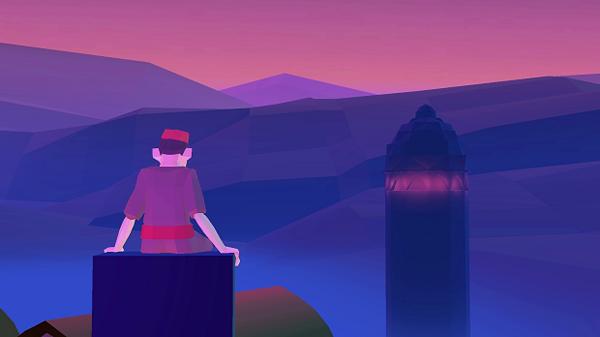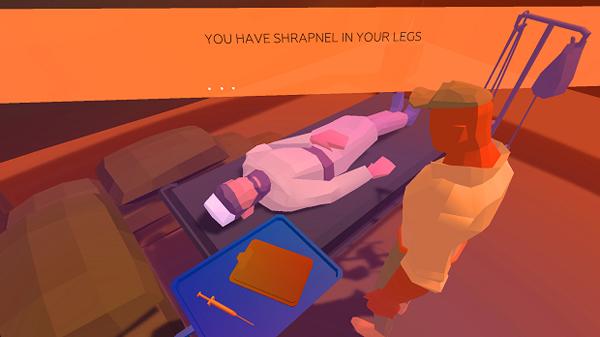The Sun Also Rises: A Conversation with Lead Designer Ty Underwood
Don Gomez
Full Disclosure: The Sun Also Rises is currently in a Kickstarter campaign in which the author of this article has contributed.]
A couple of weeks ago, an article about an upcoming video game about war that doesn't involve any shooting caught my eye. The graphics were boxy and abstract, reminiscent of Another World. The colors were bright and dreamy. I clicked through and watched the teaser. From just that short video, I felt like I was looking at the beginning of a video game that might finally capture the "what it's like" question that people are so eager to ask returning soldiers.
As a military-gamer, and someone who has made the full transition in and out of service (and back again!) I was especially intrigued by the concepts behind the game. As much as I enjoy first-person shooters, Call of Duty and Ghost Recon are caricatures of war. I've found that dialogue driven games that provide the player choices that effect outcomes, like Mass Effect are much more realistic.
From their Kickstarter page:
"A Multiplayer Narrative Adventure that explores the Global War on Terror through stories based on U.S. Soldiers, their families and people from Afghanistan. The Sun Also Rises focuses on empathizing with human struggle and portrays a side of war that is often overlooked."
Elements of PTSD, sexual assault, and the transition back to civilian life will appear. The game will also feature a "passive multiplayer" element, where the decisions of one character playing the game will affect other players.
I contacted Ty Underwood, the lead designer of The Sun Also Rises to have a conversation about the game. Below is the conversation, edited for readability and clarity.

Don: So the first thing that caught my eye with The Sun Also Rises was the color/music/dream-like quality of the teaser. Can you talk a little bit about the design and if that "dream-like" feel is something you're shooting for?
Ty: One of the things I noticed during the interviews with soldiers was there were a few times where some of them would argue a bit because they remembered things happening differently. I think that part is really important to how they parsed and communicated their experiences. I want to communicate that visually and not just with text. I looked at a lot of Pakistani and traditional Afghan textile art and a lot of contemporary art as well. Mahwish Chisty does some really intense installations and paintings about drones that were a big inspiration.
It looks like war "as I would remember it" and not actually as it happened, which in a way makes it feel "more real" than it actually was – if that makes any sense.
Yeah, that makes a lot of sense. I was really influenced in this area by Tim O'Brien's book The Things They Carried. In it, he talks a lot about how war stories are equal parts telling what happened in war and communicating emotionally that same story.
I always liked that in The Things They Carried you could never quite tell if the story was real or fantasy – like the scene of the platoon getting mortared in the mud field.
Yeah, and the way the author keeps backing out of the 'author' voice into a sort of meta-voice is really interesting and heightens the tensions. He wants you to wonder if it's really true and then think about why you want that to be true. We're trying to capture that in the game.
There's a scene in the teaser of a subway station and a train rushing by. There is something strangely jarring about a subway station. I can remember hundreds of times, standing on a subway platform as a train rushed by, my mind drifting back to Iraq. I'm curious to know more about the civilian interaction piece and the "post-war/veteran" aspect of the game, because I think a lot of veterans will be specifically interested in that being captured in a video game.
One reason we went with a subway specifically is because August [one of the game's developers] grew up in that exact part of New York and when he was a little kid he had to navigate the subway system by himself every day to get back and forth to school. He's taking charge of the visual direction and the strangeness and juxtaposition [of war and a subway station] is really powerful for him. I also interviewed a veteran who came home to New York after leaving the service and that helped put that part of the story together.

In the teaser, it has a similar effect of the supermarket scene in The Hurt Locker.
Yeah, The Hurt Locker has some really powerful imagery that transports you like that. Subways and airports are some interesting and bare architectural spaces that really hold meaning for soldiers coming home.
So part of the game – for the soldier character – is outside of Afghanistan?
Yes, a lot of it will be stateside. One of the playable characters, the CIA analyst, is based in the US. The combat medic character will move fluidly back and forth depending on how the story is unfolding. A lot of the soldiers I spoke with talked about how repeat deployments are a big part of their life and they never felt "totally deployed" or "totally home."
To capture that, the decisions that you make can transport your character back and forth through time and space. This will be reflected not only on where and when your character physically is, but by changes in the lighting or color palette. As a player, you know that this game is taking place partially in the character's emotions and in your own emotions.
You have stated in other articles that you are trying not to depict "good or bad" sides in the story, but simply tell the story of the characters. What are the concerns with "getting it right?"
When I first started, I was ready to drop the project if a significant portion of the people I talked to thought it was a bad idea or what I was doing was disrespectful or dishonest. The feedback that I've been getting from veterans, even in places like YouTube comments have been surprisingly almost universally positive. The only real negative feedback are people who claim to be speaking for veterans or speaking for the Afghan people, but aren't actually from either of those groups. And even then, negative feedback has been few and far between.
Games are tricky, because films and journalistic pieces seem to have a cultural currency that means their authenticity doesn't get questioned until after someone judges the work. Games still have a long way to go to get that vote of confidence. I'm not resentful of that, just aware of it. So getting feedback through the entire process is important. I'm still ready to cut out sections if they aren't going to work.
The interviews are the most important part, but I am also receiving help from academics and journalists who already work through parsing military history and have a lot of experience in research.
So how do you protect the game's vision through that feedback?
One way to protect the core experience is that your decisions aren't reflected in big set pieces as much as how the characters relate to each other. This is is a cool thing about games because my feelings going into it are going to get feedback like yours will. But while the vision absolutely deserves to be the subject of criticism, I have to rely on the team and the people I've come to trust in this process to help make final calls about difficult decisions we make. Something I've been really lucky to have is a network of friends who are soldiers or game designers or historians who are super involved in the success of the game. Doing something different is risky but that's all we want.
In terms of gameplay, what can you compare The Sun Also Rises to? The subject matter is heavy, but how is it going to be fun?
We're attacking this from a few angles. Unlike something like The Walking Dead, you're not going to be around choosing four dialog options. There are sections where you engage in dialogue, a little more like some of those interactive fiction games, like Horse Master. Other parts will have a gestural communication thing going on, where you could liken it a bit to a fighting game. Not literally, of course. Fighting games are about managing spacing and rhythm. And instead of just pointing a gun at people and shooting them we're prototyping sections where you can use body language and gestures with someone who speaks a different language, where hopefully it does not escalate to the point that you have to level your gun.
The CIA analyst has her own gameplay sections that are a bit more investigative. Think whiteboards where you need to figure out the relationship between different targets by exploring memories and documents and figuring out ways to capture targets without all of the information. A bit of Papers Please, a bit of Phoenix Wright.
So with her there is a puzzle element?
It's all about getting the bigger picture and managing risk for ground troops, so yeah, you can say puzzle. But more about piecing together as much as you can, less about solve equals win. That is one of the things that involves the multiplayer.
Do you envision an "ending" for the game?
I'm not solid but we're thinking about doing it episodically. There will be an ending to the story, but the story will also cascade into the story of the next person who plays the game. That's as far as I go without spoiling anything.
My brain can't even process that anyway, although it sounds awesome.
Hah, I'm glad.
The Sun Also Rises is currently in a Kickstarter campaign that ends on September 7th. Follow@horsevolume on Twitter.
Don Gomez is a writer for Front Towards Gamer, the brain child of site founder Steve "Shanghai Six" Machuga, created with the intent of carving out a small place on the internet to call home. Follow @dongomezjr on Twitter.










